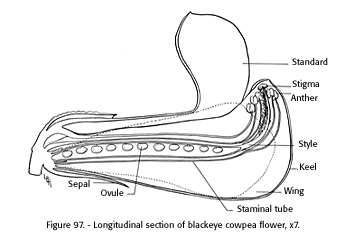COWPEA
Vigna sinensis Savi (L.) ex Hassk., family LeguminosaeThe cowpeas inculde the blackeyes, cream, crowders, purplehull, and some other less common types. They are grown primarily in the South and in California. Production of cowpeas decreased from 899,000 acres in 1954 to 93,000 acres in 1967 when the USDA ceased including the crop in the annual Agricultural Statisti report. The farm value also decreased from $8,600,000 in 1954 to $3,150,000 in 1967.
Plant:
Cowpeas may be prostrate, erect, or climbing to about 3 feet. They are sensitive to cold and are killed by frost, but are tolerant to heat and drought conditions. The seeds are planted after all danger of frost is past. The plants flower in midsummer, and the seeds or forage are harvested before frost. The trifoliate leaves, 2 to 5 inches across, form a dense canopy that covers the ground. The seeds are in slender pods 8 to 10 inches long with eight to 20 seeds;vary in size (2 to 12 mm), shape (globular to kidney shaped), texture (smooth or wrinkled), and color (white, green, buff, red, brown, or black; and are variously speckled, mottled, blotched, or eyed). The type of cultivar grown depends upon whether it is to be used to produce forage, green pods, or the dry seeds as a pulse crop.
Inflorescence:
The inflorescence consists of two to eight whitish, yellowish, or violet papilionaceous flowers in pairs crowded together on the tip of a slender peducle or stem, 1 inch to 6 inches long. The 3/4- to 1-inch flower has a bent style, bearded on the inner curve immediately below the oblique stigma, and uniform anthers in two fused groups around the style (fig. 97).
The flower has a single ovary with eight to 20 ovules. Extrafloral nectaries are located at the base of the corolla. Whether floral nectar is secreted is not clear, but most likely it is.
The flower is attractive to bumble bees and various other insects that forage upon both the nectar and pollen.
[gfx]
FIGURE 97. - Longitudinal section of blackeye cowpea flower, x 7.Pollination Requirements:
Purseglove (1968*) stated that the flowers open early in the morning and close before noon of the same day. Warnock and Hagedorn (1954) stated that the stigma is receptive only one day at 68 deg to 72 deg F but slightly longer at 60 deg. Robbins (1931 ) stated that the cowpea is capable of self-fertilization, and this is probably the common occurrence, although the flowers are often visited by honey bees or bumble bees, attracted chicfly by the extrafloral nectar. However, Warnock and Hagedorn (1964), after detailed study of the stigma of the cowpea, learned that receptivity is limited to only the very tip of the stigma, which in appearance somewhat resembles the sensitive end of the trunk of the elephant. They also found that from 14 pollinations made in the greenhouse, 59 seeds set when pollen was placed on the end of the stigma but only seven set when pollen was rubbed on the style. It was interesting that they never got more than an average of 5.4 seeds per pollination when pods normally produce eight to 20 seeds, which would indicate that their method was not as efficient as the natural method.
Pollinators:
Purseglove (1968*) stated that a heavy insect is required to depress the wings of the flower and expose the stamens and stigma. The pollen is sticky and heavy, indicating that the plant is not wind-pollinated (Mackie 1946). Cross-pollination seems to be associated with areas where bumble bees are numerous. Mackie and Smith (1935) stated that bumble bees are the primary pollinators.
The actual value of frequent visitation by pollinating insects to blossoms of cowpeas has not been determined; however, the study by Warnock and Hagedorn (1954) would indicate that such activity is beneficial in increasing the number of pod set, the number of seeds per pod, or both.
A male-sterile mutant cowpea has been reported (Sen and Bhowal 1962). It has not been utilized in hybrid seed production, but if such a mutant were used, since cowpeas are not wind pollinated, insects large enough to operate the floral mechanism would be required to carry pollen from fertile to male-sterile plants.
Pollination Recommendations and Practices:
There are no recommendations for the use of pollinating insects on cowpeas.
LITERATURE CITED:
MACKIE, W. W.
1946. BLACKEYED BEANS IN CALIFORNIA. Calif. Agr. Expt. Sta. Bul. 696, 56 pp.____ and SMITH, F. L.
1935. EVIDENCE OF FIEBD HYBRIDIZATION IN BEANS. Amer. Soc. Agron. Jour. 27: 903 - 909.ROBBINS, W. W.
1931. THE BOTANY OF CROP PLANTS. Ed. 3, 639 pp. P. Blakiston's Son & CO., Inc., Philadelphia.SEN, N. K., and BHOWAL, J. G. A.
1962. A MALE-STERILE MUTANT COWPEA. Jour. Hered. 53(1): 44-46.WARNOCK, S. J., and HAGEDORN, D. J.
1954. STIGMA RECEPTIVITY IN PEAS (PISUM SATIVUM B.). Agron. Jour. 46: 274.

